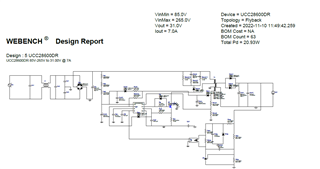Other Parts Discussed in Thread: UCC28600, UCC28056, UCC28050, UCC28051, PMP9730, POWERSTAGE-DESIGNER, UCC256404, UCC256403, UCC38050, UCC38051, UCC28740
- I used WEBENCH but i want probe some points on schematic (add probe in specific point) . how do I do that?
- Is there is another IC part with power factor correction? My requirements AC to DC converter with power factor correction AC input 85V -265V Frequency 60Hz output 31DC @ 7A High efficiency.
another part # UCC28600
Regards
Sam

https://webench.ti.com/power-designer/switching-regulator/export/5?noparams=0





